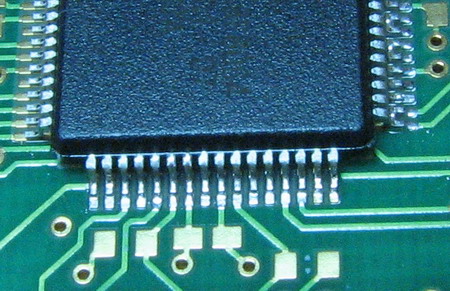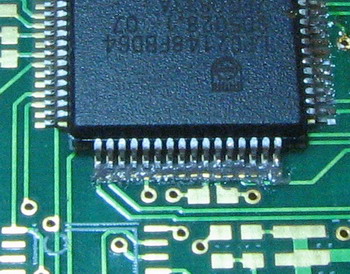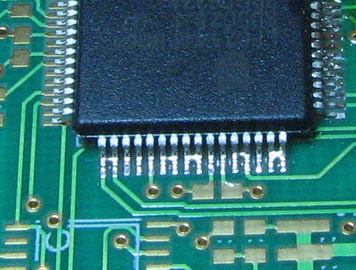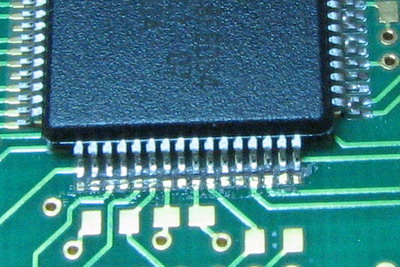Difference between revisions of "Tiny Assembly"
| Line 27: | Line 27: | ||
During the assembly of 5 Tiny13 1.1 units it was found to expect them to draw around 45mAh @ 12.3V input. Since the Tiny13 uses a switching supply, realize that you will see varying currents with varied input voltages. With the LEA-4P absent the circuit should draw 25mAh @ 12.3V. | During the assembly of 5 Tiny13 1.1 units it was found to expect them to draw around 45mAh @ 12.3V input. Since the Tiny13 uses a switching supply, realize that you will see varying currents with varied input voltages. With the LEA-4P absent the circuit should draw 25mAh @ 12.3V. | ||
== Some thoughts about starting up a Tiny == | |||
* populate all parts except the GPS rx for first tests to make them simpler | |||
* check the polarity of all parts, compare to a picture of a working reference board | |||
* use a microscope or a magnifying glass to check for short circuits | |||
* use a power supply for first tests, not a battery, limit the current to about 100mA, use a voltage of about 7V | |||
* use the on-board supply, do not try to feed voltage from the outside | |||
* the 7V should not drop due to current limiting, measure the 5V and the 3.3V supply on the board | |||
-> wrong voltages: check the parts around the power supply | |||
* measure the current, it should be around 50mA at 7V with the LPC running and no code loaded (switching supply: reduces to around 25mA @12V) | |||
* attach reset, therefore connect LPC_RESET to GND (the board button is NOT reset), current should reduce to 15mA at 7V (10mA @12V) | |||
-> check if reset signal can be measured at the LPC reset pin 57 | |||
* check the 12MHz at LPC pin 61, XTAL2 (XTAL_out) | |||
* connect LPC_TXD_0 and LPC_RXD_0 of Serial1 to the serial port of your PC through a 3.3V-USB-RS232 converter (LPC_TXD_0 - PC_RX, LPC_RX_0 - PC_TX), attach LPC_P0.14 to a buffered PC_RTS or connect to a button | |||
* run the serial ROM loader lpc21isp to flash USB bootloader with | |||
make bl_upload | |||
* press the LPC_P0.14 button if not connected to RTS and reset the board | |||
-> check the rx/tx pins for data if flashing does not succeed | |||
* deattach the LPC_P0.14, reset the board | |||
* the USB bootloader outputs debug information with 115200 8N1 on the serial port | |||
-> try the uart_tunnel from arm7/test, logical high and low should be sent from LPC_RXD_0 to LPC_TXD_1 and LPC_RXD_1 to LPC_TXD_0 (at GPS pins) | |||
* LPC_P0.23 (USB Vbus) should be low, LPC_USB_CONNECT high | |||
-> check parts around Q1 | |||
* connect USB+ (D+), USB- (D-), LPC_P0.23 (USB Vbus) and GND of Serial2 with your PC, reset the board | |||
* LPC_P0.23 (USB Vbus) should go high from PC USB, LPC_USB_CONNECT should go low through LPC software | |||
* the PC will detect a new USB device, check with "dmesg" and "lsusb" | |||
-> if a new USB device is detected but does not accept new address, the USBconnect worked, but not the communication, check USB+ and USB- | |||
* flash the autopilot with | |||
make [AIRCRAFT] ap.upload | |||
* the LEDs should work according to your configuration | |||
* check telemetry through serial port, messages should be displayed | |||
* test A/D converters for supply voltage and IR sensors | |||
* check modem, connect tx, rx, gnd and supply | |||
* solder GPS, current should increase to about 100mA at 7V in the lab with no sats visible (60mA @ 12V) | |||
* try to aquire sats outside | |||
Revision as of 12:44, 11 July 2007
LEA-4P Mounting
It is advised not to use hot air reflow rework station / solder paste for this assembly as it is quite easy to "blow" solder underneath the LEA-4P causing a short. Instead apply a small amount of solder flux paste and a fine tip soldering iron w/ fine solder. Print out the schematic to see the required pin wiring. Solder only the necessary pins, you will realize why if you ever have to remove the LEA-4P module from the PCB. Realize that the footprint is not symmetrical and will only mount one way so you do not have to go crazy making sure you have the black dot facing the right direction.
Solder Paste Usage
Solder paste can easily become your secret weapon against the difficult placing of the fine-pitch components in use in this project. The most crucial parameter you can control is how much solder paste is used. If too much is used (even 1/10 of a gram too much), you will be left removing many solder bridges between pins and pads manually. Alternatively if too little is used you will be left individually soldering pins.
Below is an example of too much
this is the result after reflowing: 5 different solder bridges that must be removed. Sometimes it is as easy as applying a small amount of liquid flux to the area then dragging a hot micro tipped iron between the two pins, drawing the bridge towards the pad. You may also want to try copper braid for wicking the excess solder away. I often find this removes too much solder.
Below is an image where an adequate amount of solder paste was applied.
The results of the above solder paste.
 Insert non-formatted text here
Insert non-formatted text here
Expected Current Consumptions
During the assembly of 5 Tiny13 1.1 units it was found to expect them to draw around 45mAh @ 12.3V input. Since the Tiny13 uses a switching supply, realize that you will see varying currents with varied input voltages. With the LEA-4P absent the circuit should draw 25mAh @ 12.3V.
Some thoughts about starting up a Tiny
- populate all parts except the GPS rx for first tests to make them simpler
- check the polarity of all parts, compare to a picture of a working reference board
- use a microscope or a magnifying glass to check for short circuits
- use a power supply for first tests, not a battery, limit the current to about 100mA, use a voltage of about 7V
- use the on-board supply, do not try to feed voltage from the outside
- the 7V should not drop due to current limiting, measure the 5V and the 3.3V supply on the board
-> wrong voltages: check the parts around the power supply
- measure the current, it should be around 50mA at 7V with the LPC running and no code loaded (switching supply: reduces to around 25mA @12V)
- attach reset, therefore connect LPC_RESET to GND (the board button is NOT reset), current should reduce to 15mA at 7V (10mA @12V)
-> check if reset signal can be measured at the LPC reset pin 57
- check the 12MHz at LPC pin 61, XTAL2 (XTAL_out)
- connect LPC_TXD_0 and LPC_RXD_0 of Serial1 to the serial port of your PC through a 3.3V-USB-RS232 converter (LPC_TXD_0 - PC_RX, LPC_RX_0 - PC_TX), attach LPC_P0.14 to a buffered PC_RTS or connect to a button
- run the serial ROM loader lpc21isp to flash USB bootloader with
make bl_upload
- press the LPC_P0.14 button if not connected to RTS and reset the board
-> check the rx/tx pins for data if flashing does not succeed
- deattach the LPC_P0.14, reset the board
- the USB bootloader outputs debug information with 115200 8N1 on the serial port
-> try the uart_tunnel from arm7/test, logical high and low should be sent from LPC_RXD_0 to LPC_TXD_1 and LPC_RXD_1 to LPC_TXD_0 (at GPS pins)
- LPC_P0.23 (USB Vbus) should be low, LPC_USB_CONNECT high
-> check parts around Q1
- connect USB+ (D+), USB- (D-), LPC_P0.23 (USB Vbus) and GND of Serial2 with your PC, reset the board
- LPC_P0.23 (USB Vbus) should go high from PC USB, LPC_USB_CONNECT should go low through LPC software
- the PC will detect a new USB device, check with "dmesg" and "lsusb"
-> if a new USB device is detected but does not accept new address, the USBconnect worked, but not the communication, check USB+ and USB-
- flash the autopilot with
make [AIRCRAFT] ap.upload
- the LEDs should work according to your configuration
- check telemetry through serial port, messages should be displayed
- test A/D converters for supply voltage and IR sensors
- check modem, connect tx, rx, gnd and supply
- solder GPS, current should increase to about 100mA at 7V in the lab with no sats visible (60mA @ 12V)
- try to aquire sats outside


